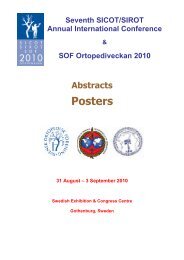SICOTNEWS
SICOTNEWS
SICOTNEWS
Create successful ePaper yourself
Turn your PDF publications into a flip-book with our unique Google optimized e-Paper software.
Country to Country Series<br />
4 <strong>SICOTNEWS</strong> | April 2009 - No. 116<br />
SICOT from the view of an<br />
Austrian SICOT President<br />
Prof Dr Rainer Kotz<br />
SICOT President 1999-2002<br />
The Austrian involvement in SICOT is as old as its birth as an<br />
international society since the early years of the 20th century.<br />
Three people were interested in a new international orthopaedic<br />
organisation:<br />
- Robert Lovell (54) from Harvard University in Boston, USA<br />
- Vittorio Putti (33) from the Instituto Orthopedico Rizzoli in<br />
Bologna, Italy and<br />
- Hanns Spitzy, (42) from the Orthopaedic Hospital in Vienna,<br />
Austria<br />
Hofrat Prof Dr Hanns Spitzy (1872-1956)<br />
Lovell discussed the idea prior to 1913 with Hanns Spitzy and<br />
Vittorio Putti and sent a letter on 25 November 1913 to Hanns<br />
Spitzy in Vienna with the idea of an international orthopaedic<br />
association. His long letter already contained a list of statutes and<br />
outlined the structure of a journal to be called “The International<br />
Journal of Orthopaedic Surgery”. He was keen to meet with<br />
Spitzy and Putti in Europe to establish the international society.<br />
Hanns Spitzy asked for and received the backing of the German<br />
Society of Orthopaedic Surgery. Putti responded by suggesting<br />
that the three of them meet that summer of 1914 (13 July) in<br />
Courmayeur (Mont Blanc, Italy). [Sorbie: “The known history of<br />
the origins of SICOT”, 1999]<br />
Unfortunately, all plans were suspended during the First World<br />
War until 1923, when Putti, Lovell (by then 63) and Sir Robert<br />
Jones met in Boston. Lovell died unexpectedly in 1924 at the<br />
home of Sir Robert Jones in England and all activities stopped<br />
again.<br />
Five years later, a letter dated 22 January 1929 from Robert B.<br />
Osgoode (Harvard, Boston) to Harry Platt (Manchester, England)<br />
again recommended a group of men should meet to discuss the<br />
idea including Sir Robert Jones, Putti, Biesalski and Spitzy. Putti<br />
suggested Paris on 10 October 1929 as the earliest and most<br />
suitable date and asked Fred Albee (New York, USA) to arrange<br />
the meeting at the Hotel Crillon in Paris.<br />
The group of founders who did attend included:<br />
Spitzy and Erlacher from Austria, Lorthioir, Delchef and, Maffei<br />
from Belgium, San Ricart from Spain, Albee, Baer and Meyerding<br />
from the USA, Ombrédanne, Rocher, Sorrel and Nové-Josserand<br />
from France, Fairbanks from Britain, Biesalski from Germany,<br />
Galleazzi and Putti from Italy, Jansen from the Netherlands, Franz<br />
Jiano from Romania, Haglund and Waldenström from Sweden,<br />
Machard from Switzerland and Zarhadnicky from Czechoslovakia.<br />
Hofrat Prof Dr Hanns Spitzy (1872-1956)<br />
Founder of the Orthopaedic Hospital<br />
The meeting took place after dinner at 10 p.m. at the Hotel Crillon.<br />
Spitzy said that the German Orthopaedic Society agreed with the<br />
plan to form the organisation and that he would act as its representative.<br />
He felt that the membership should not be nominated by the national<br />
orthopaedic or surgical societies, but that in each country a committee<br />
consisting of well known scientific working orthopaedic surgeons<br />
should nominate appropriate individuals. He said that the Nominating<br />
Committee should consist of those present as charter members.<br />
Spitzy felt very strongly that good and appropriate members were<br />
often not members of national societies.<br />
In 1924 when Spitzy was proposed as successor of Adolf Lorenz<br />
at the University of Vienna by the Nominating Committee he was<br />
rejected.<br />
Hofrat Prof Dr Adolf Lorenz (1854-1946)<br />
The plans for an Orthopaedic Department at the University of<br />
Vienna were suspended and orthopaedics was back again as part of<br />
the Surgical Department with Julius Hass as its leader. With this<br />
experience in mind, Spitzy was in favour of a National SICOT<br />
Committee independent of universities and national societies,<br />
especially where orthopaedics was not a separate department at the<br />
Medical Faculty of the National University. Maybe other members<br />
had had similar experiences and therefore Spitzy’s proposal was<br />
taken into consideration.

















